Start fresh
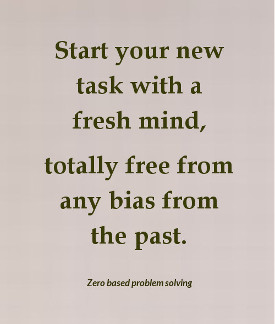
We tend to start a problem solving process with previous bias. Admitting that we can’t be totally free of bias, it is of great importance to start solving a new problem from as much neutral a standpoint as possible.
It will enable you to properly analyze the new problem on its own merit. After this analysis, if need be, you will use the known problem solving approaches, principles, techniques and tools suitable for solving this specific problem.
At the very beginning, before analyzing the problem well, you should have no opinion regarding how you will go about solving this problem.
You will start with a clean slate, a zero base and an alert and bias-free analytical mind, prepared for anything. As you proceed towards the solution step by step, gradually you will start forming rules and patterns that should be effective in solving this specific problem.
This is what we call the Principle of Zero Based Problem Solving.
Here we have used the abstract idea of zero based approach in problem solving to form a useful principle. The important concept here is the idea of zero based approach. It simply means, start fresh.
It is a powerful approach and can be used in many varied situations in our lives when we are doing tough tasks one after the other, specially under time pressure.
Examples are all around us. In many competitive tests, after two hard questions an easy question pops up, and the student might falter trying to solve the easy one in a complicated way. In competitive sports, professional players must focus on the present match fully, not influenced by any of the results of the previous matches. A doctor must analyze a patient's symptoms on its own merit. His previous patient's symptoms and analysis should no way affect his present analysis except as already formed useful rules.
And life is - solving a series of problems. Every such problem needs to be dealt with independently on its own merit.
Let's experience a problem solving process.
Learning from solving Four Square Problem
Problem statement:
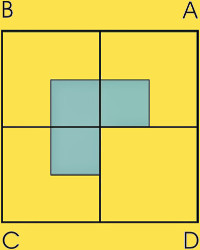
Question 1: Divide the yellow unshaded area in square A into two equal parts. Think over, it's easy.
Hoping that you have solved the first question let's face the second one.
Question 2: Divide the yellow unshaded area in square B into three equal parts. Look at the unshaded portion of square B and soon you should find the answer.
Assuming again that you have got the correct answer at this second step, let's face the third question now.
Question 3: Divide the yellow unshaded area in square C into four equal parts.
This may be a bit more difficult, but don't stop trying. Solve this question and measure your time.
Here comes the fourth and the last question. Be prepared.
Question 4: Divide the yellow area in square D into seven equal parts.
Think through, try seriously and then only go further.
Analysis and solution
Solution to question 1
Solution to the first question is easy. The red diagonal line divides the unshaded area in square A into two equal parts. It is generally visible to most people in a few seconds.
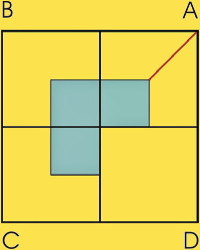
Solution to question 2
While looking for the second answer, we may visualize the empty area as a collection of three equal squares. Basically in this case, square B is visualized in terms of a square made up of four smaller squares. For this answer most probably you didn’t have to wait long. By visual inspection, the answer comes easily.
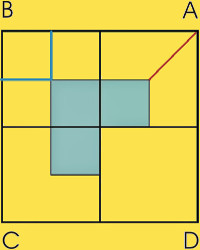
Solution to question 3
Perhaps the third question gave you some trouble. At least it gave us a little trouble. By previous bias we tried to think square C as a square made up of four squares. Within a few seconds we found our mistake - this approach won't take us to the solution. Basically the unshaded portion here consists of three equal squares. We need to divide it into four equal parts. Divide three into four - how?
How can we divide a three unit area into four equal parts?
Can we break down each part of the three part piece into four still smaller parts? If we do that we will get 3x4, that is, 12 smaller parts. These parts are equal squares. Oh yes, we have got the solution now. Combine three such adjacent squares together. Do it suitably three times and you will get your four equal areas. When you do the third time, the fourth area will automatically be created. The breakdown of the three small squares is shown below. The red dotted lines show the boundary of the squares.
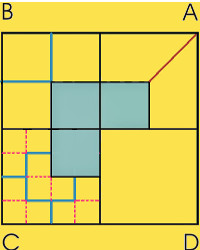
Instead of dividing each of the three smaller squares of yellow unshaded area of square C into four equal still smaller squares, we could have divided each into four triangles. Grouping the resulting 12 triangles into four adjacent clusters of three triangles each would also have lead us to the desired solution. This is a second alternate solution.
While learning problem solving, we always ask, "In how many more ways this problem can be solved?" Advantages of this approach are threefold. This approach,
- strengthens your ability to see many paths to the solution that are not easily visible
- gives you a chance to evaluate the alternative paths to the solution, and
- strengthens your exhaustive thinking ability
We call this important approach as, Problem solving in many ways approach. As such it is not a problem solving resource - rather it is a problem solving skill building method. It simply states,
Solve an already solved problem in as many efficient ways as possible.
Being problem solvers we cannot forget the efficiency of a solution.
Coming back to our problem, which principles did we use till now? In the question 2, we straightway divided the empty space into three equal parts. That method we can’t follow here we have tried and found out. This learning was through analysis and application of Principle of Fresh Start or zero based problem solving.
This step of problem analysis is vital in learning the nature and anatomy of the problem. At this step we have also discovered that we need to divide a three unit area into four equal smaller pieces.
With this vital knowledge we further discovered that dividing each of the smaller squares into 4 still smaller squares (or triangles) and then grouping the resulting 12 squares (or triangles) into four groups would give us our solution.
We have used two inventive principles here:
-
First we have used: Principle of Segmentation (or dividing or fragmenting), and
-
Next we have used: Principle of Merging (or combining similar things).
These are two of the leading principles in the set of 40 inventive principles of TRIZ. These principles have very wide applications.
Solution to question 4
Let us come to the fourth solution now. In this case we don't have the unshaded area - the whole of square D is to be divided.
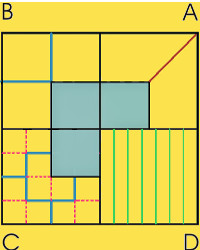
After the intial delay of about 10 seconds, we have straightway measured one side of the square D and divided the side into seven parts by drawing six straight lines parallel to the vertical side.
What is your experience in answering the fourth question? Either you know the answer instantly or you find it difficult. If you get the solution instantly, you have used your intuition. Intuition is also a powerful mechanism towards problem solving, no second thoughts about it. Intuitive problem solving is fastest.
In emergent situations such as fire-fighting, front-line battle in a war split second decision making is the necessity and that kind of decision making is mostly intuitive based on experience and training.
Unfortunately for us, we were stalled again at this fourth step for about 10 seconds trying to segment the totally empty square D using the complex methods we had used in question 3 just before.
Previous bias
That was bias. This is one example of the need to start fresh without any bias. The more you move along the earlier path, further away you will move from the solution.
Quickly though we recognized our mistake and started to think fresh from a zero base. It became immediately apparent that we can divide the fully empty square into any number of equal pieces by just dividing one of its sides into equal portions and drawing straight lines parallel to its perpendicular side through these equal portions.
This is another kind of segmentation, but used differently. We are segmenting a space by segmenting a length.
This is more versatile, as by applying this concept you can actually divide the square into any number of equal portions. So we say,
Application of this concept here is more general in scope.
While solving the apparently easy four stage problem, we were stalled unexpectedly twice. At stage 3, the delay was minor, but the deliberately created misdirection at the transition from question 3 to question 4 caught us napping. That is where we became aware of the need of zero based problem solving without any previously acquired bias.
This is an academic artificially created problem, but we also realized,
While going through life and facing a stream of problems, misdirection from bias may happen anytime,
unless we always face a problem with a no-bias totally neutral mind.
